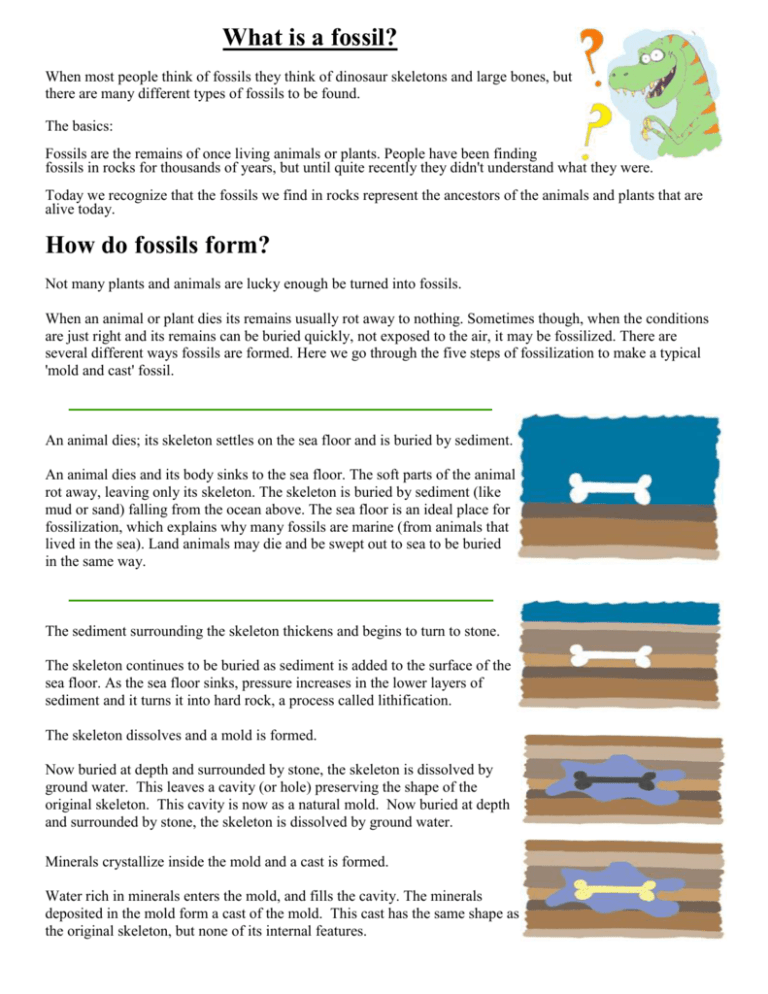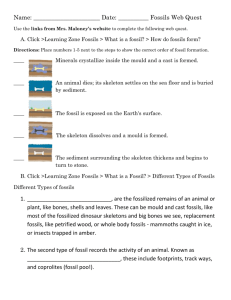fossil article
advertisement

What is a fossil? When most people think of fossils they think of dinosaur skeletons and large bones, but there are many different types of fossils to be found. The basics: Fossils are the remains of once living animals or plants. People have been finding fossils in rocks for thousands of years, but until quite recently they didn't understand what they were. Today we recognize that the fossils we find in rocks represent the ancestors of the animals and plants that are alive today. How do fossils form? Not many plants and animals are lucky enough be turned into fossils. When an animal or plant dies its remains usually rot away to nothing. Sometimes though, when the conditions are just right and its remains can be buried quickly, not exposed to the air, it may be fossilized. There are several different ways fossils are formed. Here we go through the five steps of fossilization to make a typical 'mold and cast' fossil. An animal dies; its skeleton settles on the sea floor and is buried by sediment. An animal dies and its body sinks to the sea floor. The soft parts of the animal rot away, leaving only its skeleton. The skeleton is buried by sediment (like mud or sand) falling from the ocean above. The sea floor is an ideal place for fossilization, which explains why many fossils are marine (from animals that lived in the sea). Land animals may die and be swept out to sea to be buried in the same way. The sediment surrounding the skeleton thickens and begins to turn to stone. The skeleton continues to be buried as sediment is added to the surface of the sea floor. As the sea floor sinks, pressure increases in the lower layers of sediment and it turns it into hard rock, a process called lithification. The skeleton dissolves and a mold is formed. Now buried at depth and surrounded by stone, the skeleton is dissolved by ground water. This leaves a cavity (or hole) preserving the shape of the original skeleton. This cavity is now as a natural mold. Now buried at depth and surrounded by stone, the skeleton is dissolved by ground water. Minerals crystallize inside the mold and a cast is formed. Water rich in minerals enters the mold, and fills the cavity. The minerals deposited in the mold form a cast of the mold. This cast has the same shape as the original skeleton, but none of its internal features. The fossil is exposed on the Earth's surface. Millions of years later, the rock surrounding the skeleton rises to the Earth's surface (this happens during mountain building, earthquakes and other earth processes). The rock is worn away by wind and rain (erosion), and the fossil is now exposed, waiting to be found! Different types of fossils There are lots of different types of fossils to be found When most people think of fossils they think of dinosaur skeletons and large bones, but there are many different types of fossils to be found. Palaeontologists, people who study fossils, divide them into two major types - body fossils and trace fossils. Body fossils show us what a plant or animal looked like. The first type, body fossils, are the fossilized remains of an animal or plant, like bones, shells and leaves. These can be mold and cast fossils, like most of the fossilized dinosaur skeletons and big bones we see, replacement fossils, like petrified wood, or whole body fossils - mammoths caught in ice, or insects trapped in amber. Petrified wood, frozen mammoths, and insects in amber are all body fossils. The second type of fossil records the activity of an animal. Known as trace fossils, these include footprints, trackways, and coprolites (fossil poo!). Footprints and coprolites are trace fossils - they show us how an animal lived. Name: ____________________________ Period: _____ 1. What is a fossil? 2. What are ideal conditions for a fossil to be formed? Give an example. 3. What is lithification? 4. What is a mold? 5. How does a mold form? 6. How is a cast formed? 7. What is the difference between a cast and the original skeleton? 8. What is a body fossil? Give an example. 9. What do body fossils show us? 10. What is a trace fossil? Give an example. 11. What do trace fossils show us?





